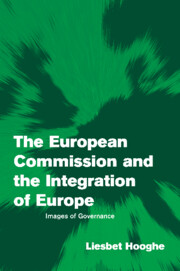Book contents
- Frontmatter
- Contents
- List of figures
- List of tables
- Preface
- Prologue
- 1 Preference formation in the European Commission
- 2 Men (and women) at Europe's helm
- 3 Images of Europe
- 4 Beyond supranational interest
- 5 Capitalism against capitalism
- 6 Principal or agent
- 7 Accommodating national diversity
- 8 Conclusion
- Appendix I Statistics
- Appendix II Description of independent variables
- Appendix III Survey material
- References
- Index
Appendix II - Description of independent variables
Published online by Cambridge University Press: 22 September 2009
- Frontmatter
- Contents
- List of figures
- List of tables
- Preface
- Prologue
- 1 Preference formation in the European Commission
- 2 Men (and women) at Europe's helm
- 3 Images of Europe
- 4 Beyond supranational interest
- 5 Capitalism against capitalism
- 6 Principal or agent
- 7 Accommodating national diversity
- 8 Conclusion
- Appendix I Statistics
- Appendix II Description of independent variables
- Appendix III Survey material
- References
- Index
Summary
Commission Socialization
Years in Commission service. Source: Biographical data from The European Companion (London: DPR Publishing, 1992, 1994); Euro's Who's Who (Brussels: Editions Delta, 1991); and from interviews by the author.
ERC-Soc
I calculate how many years each official spent in DGs dealing with European regulated capitalism. I use a restrictive definition of services for European regulated capitalism: social regulation (social policy, culture, environment, vocational training and education, consumer services: DGs V, X, XI, XXII, XXIV) and redistribution (agriculture, third world development, fisheries, regional policy: DGs VI, VIII, XIV, XVI). Source: biographical data and interviews.
Cabinet Experience
A dummy, with a value of 1 for those who served in a Commission cabinet. Source: biographical data and interviews.
National Administration
Years in national service. These concern positions in the executive branch of the state and hierarchically subordinate to central government: civil servants in line ministries, diplomats (excluding EU postings), and government ministers (but not national parliamentarians). For public officials with some autonomy from central authorities (courts, central bank, parliament, public companies, local government) or in positions with a strong European component (European desks in foreign affairs or near the head of government), I divide the number of years by two. Source: Biographical data and interview data.
Type of National Administration: Strong/Medium/Weak Weberian
Three dummies that tap strong/medium/weak Weberian bureaucratic tradition. I compare bureaucracies along four dimensions developed by Edward Page, and use these comparisons to categorize bureaucratic traditions along a consociational–Weberian dimension.
- Type
- Chapter
- Information
- The European Commission and the Integration of EuropeImages of Governance, pp. 224 - 232Publisher: Cambridge University PressPrint publication year: 2002

